Simcoa Operations Pty Ltd: Business Context, Risks, and Performance
VerifiedAdded on 2021/06/17
|10
|2446
|472
Report
AI Summary
This report provides a comprehensive analysis of Simcoa Operations Pty Ltd, an Australian-based company specializing in silicon production. It begins by outlining the company's organizational structure, which is characterized by a traditional hierarchy with the CEO at the top, followed by the board of directors, senior management, and finally, the workforce and supervisors. The report then delves into the internal and external environmental forces affecting the company, including its strengths, weaknesses, and the impact of political, technological, and economic factors. A significant portion of the report is dedicated to identifying and assessing the various risk factors faced by Simcoa Operations, such as fluctuations in demand, government regulations, and competition. The report proposes regionalization as a key strategy to enhance organizational performance, particularly by focusing on markets with high silicon demand. Additionally, the report highlights the importance of technological advancements and maintaining product quality. The conclusion emphasizes the importance of regionalization for Simcoa Operations to maintain its leading position in the international silicon market and provides recommendations for strategic improvements.
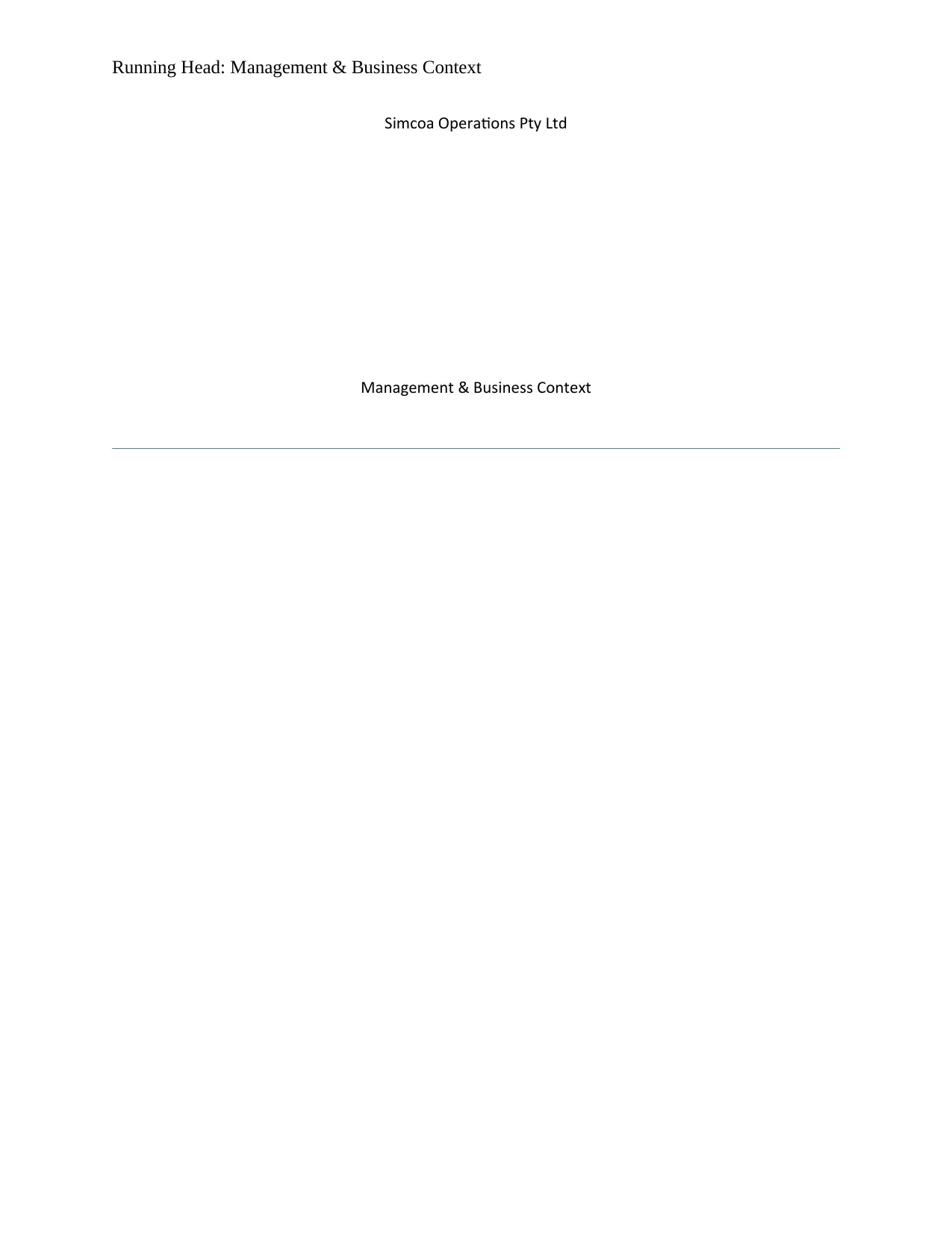
Running Head: Management & Business Context
Simcoa Operations Pty Ltd
Management & Business Context
Simcoa Operations Pty Ltd
Management & Business Context
Paraphrase This Document
Need a fresh take? Get an instant paraphrase of this document with our AI Paraphraser
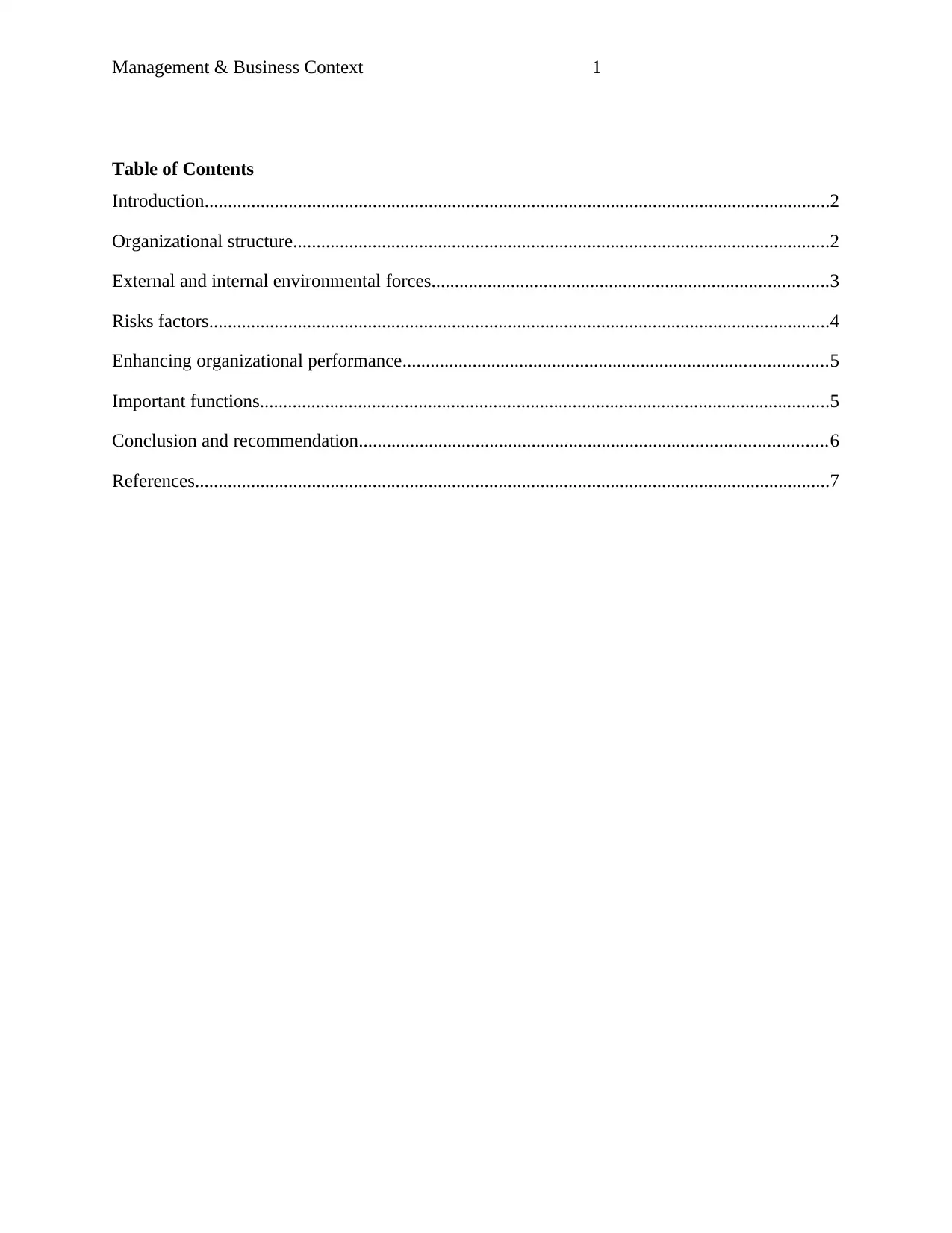
Management & Business Context 1
Table of Contents
Introduction......................................................................................................................................2
Organizational structure...................................................................................................................2
External and internal environmental forces.....................................................................................3
Risks factors.....................................................................................................................................4
Enhancing organizational performance...........................................................................................5
Important functions..........................................................................................................................5
Conclusion and recommendation....................................................................................................6
References........................................................................................................................................7
Table of Contents
Introduction......................................................................................................................................2
Organizational structure...................................................................................................................2
External and internal environmental forces.....................................................................................3
Risks factors.....................................................................................................................................4
Enhancing organizational performance...........................................................................................5
Important functions..........................................................................................................................5
Conclusion and recommendation....................................................................................................6
References........................................................................................................................................7
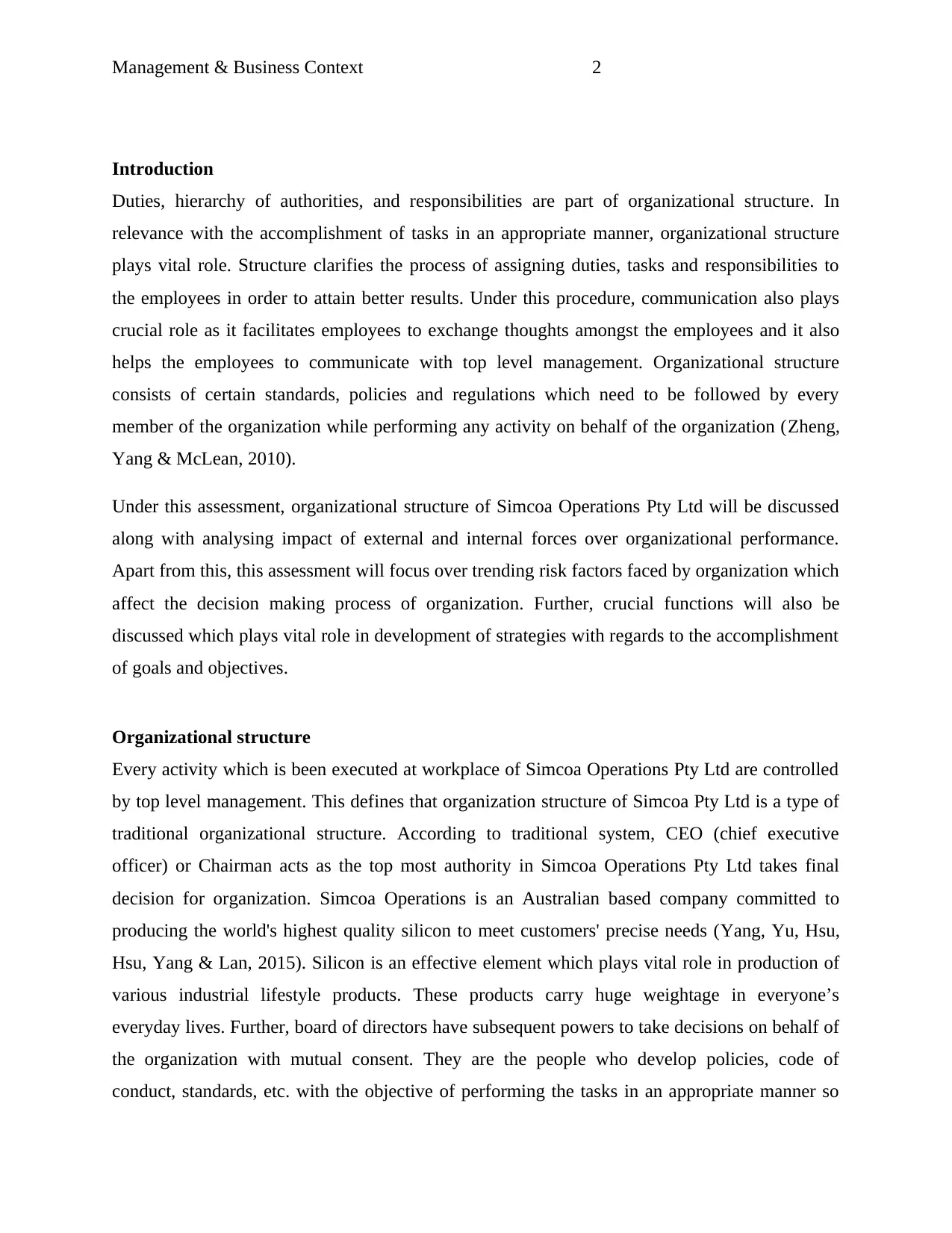
Management & Business Context 2
Introduction
Duties, hierarchy of authorities, and responsibilities are part of organizational structure. In
relevance with the accomplishment of tasks in an appropriate manner, organizational structure
plays vital role. Structure clarifies the process of assigning duties, tasks and responsibilities to
the employees in order to attain better results. Under this procedure, communication also plays
crucial role as it facilitates employees to exchange thoughts amongst the employees and it also
helps the employees to communicate with top level management. Organizational structure
consists of certain standards, policies and regulations which need to be followed by every
member of the organization while performing any activity on behalf of the organization (Zheng,
Yang & McLean, 2010).
Under this assessment, organizational structure of Simcoa Operations Pty Ltd will be discussed
along with analysing impact of external and internal forces over organizational performance.
Apart from this, this assessment will focus over trending risk factors faced by organization which
affect the decision making process of organization. Further, crucial functions will also be
discussed which plays vital role in development of strategies with regards to the accomplishment
of goals and objectives.
Organizational structure
Every activity which is been executed at workplace of Simcoa Operations Pty Ltd are controlled
by top level management. This defines that organization structure of Simcoa Pty Ltd is a type of
traditional organizational structure. According to traditional system, CEO (chief executive
officer) or Chairman acts as the top most authority in Simcoa Operations Pty Ltd takes final
decision for organization. Simcoa Operations is an Australian based company committed to
producing the world's highest quality silicon to meet customers' precise needs (Yang, Yu, Hsu,
Hsu, Yang & Lan, 2015). Silicon is an effective element which plays vital role in production of
various industrial lifestyle products. These products carry huge weightage in everyone’s
everyday lives. Further, board of directors have subsequent powers to take decisions on behalf of
the organization with mutual consent. They are the people who develop policies, code of
conduct, standards, etc. with the objective of performing the tasks in an appropriate manner so
Introduction
Duties, hierarchy of authorities, and responsibilities are part of organizational structure. In
relevance with the accomplishment of tasks in an appropriate manner, organizational structure
plays vital role. Structure clarifies the process of assigning duties, tasks and responsibilities to
the employees in order to attain better results. Under this procedure, communication also plays
crucial role as it facilitates employees to exchange thoughts amongst the employees and it also
helps the employees to communicate with top level management. Organizational structure
consists of certain standards, policies and regulations which need to be followed by every
member of the organization while performing any activity on behalf of the organization (Zheng,
Yang & McLean, 2010).
Under this assessment, organizational structure of Simcoa Operations Pty Ltd will be discussed
along with analysing impact of external and internal forces over organizational performance.
Apart from this, this assessment will focus over trending risk factors faced by organization which
affect the decision making process of organization. Further, crucial functions will also be
discussed which plays vital role in development of strategies with regards to the accomplishment
of goals and objectives.
Organizational structure
Every activity which is been executed at workplace of Simcoa Operations Pty Ltd are controlled
by top level management. This defines that organization structure of Simcoa Pty Ltd is a type of
traditional organizational structure. According to traditional system, CEO (chief executive
officer) or Chairman acts as the top most authority in Simcoa Operations Pty Ltd takes final
decision for organization. Simcoa Operations is an Australian based company committed to
producing the world's highest quality silicon to meet customers' precise needs (Yang, Yu, Hsu,
Hsu, Yang & Lan, 2015). Silicon is an effective element which plays vital role in production of
various industrial lifestyle products. These products carry huge weightage in everyone’s
everyday lives. Further, board of directors have subsequent powers to take decisions on behalf of
the organization with mutual consent. They are the people who develop policies, code of
conduct, standards, etc. with the objective of performing the tasks in an appropriate manner so
⊘ This is a preview!⊘
Do you want full access?
Subscribe today to unlock all pages.

Trusted by 1+ million students worldwide
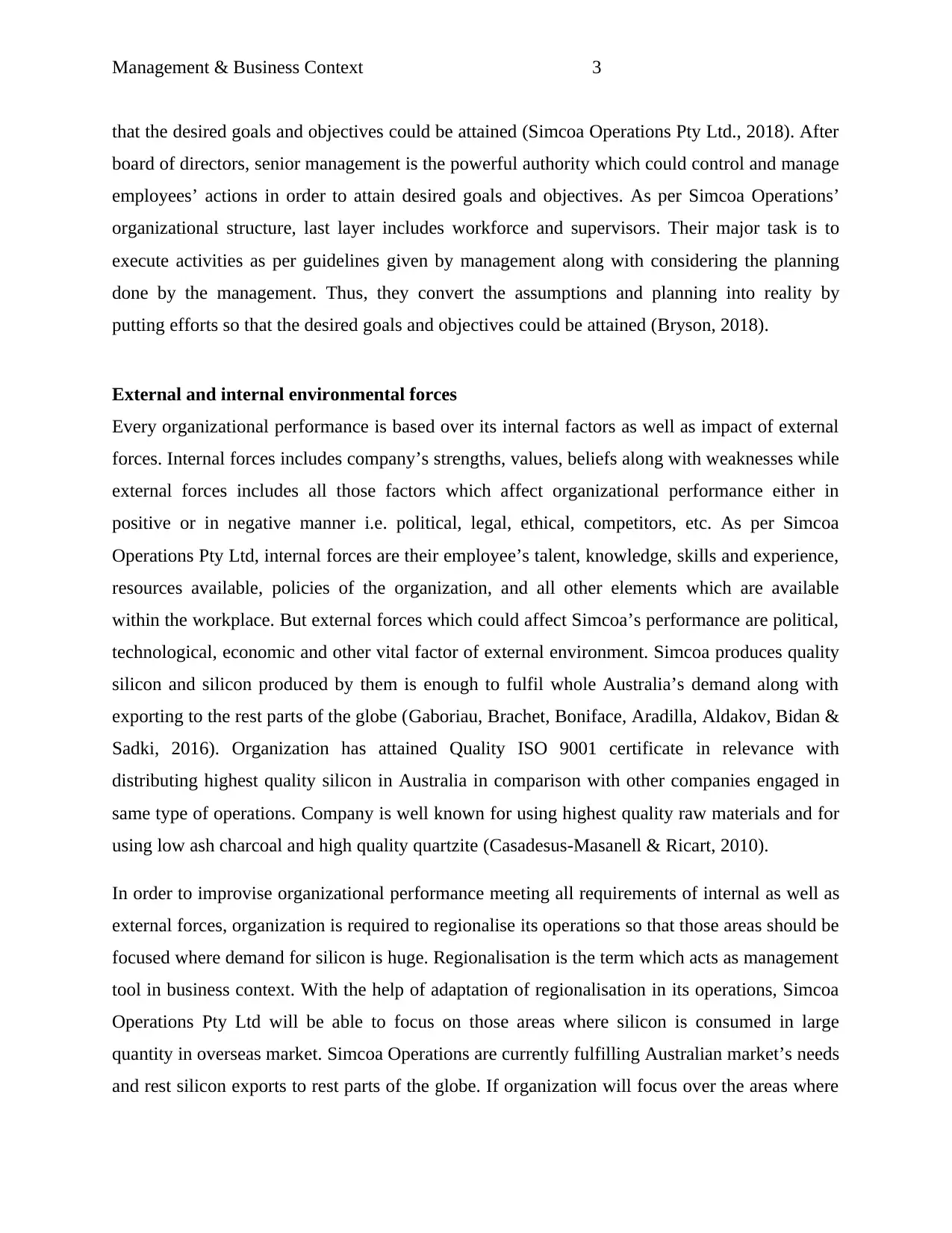
Management & Business Context 3
that the desired goals and objectives could be attained (Simcoa Operations Pty Ltd., 2018). After
board of directors, senior management is the powerful authority which could control and manage
employees’ actions in order to attain desired goals and objectives. As per Simcoa Operations’
organizational structure, last layer includes workforce and supervisors. Their major task is to
execute activities as per guidelines given by management along with considering the planning
done by the management. Thus, they convert the assumptions and planning into reality by
putting efforts so that the desired goals and objectives could be attained (Bryson, 2018).
External and internal environmental forces
Every organizational performance is based over its internal factors as well as impact of external
forces. Internal forces includes company’s strengths, values, beliefs along with weaknesses while
external forces includes all those factors which affect organizational performance either in
positive or in negative manner i.e. political, legal, ethical, competitors, etc. As per Simcoa
Operations Pty Ltd, internal forces are their employee’s talent, knowledge, skills and experience,
resources available, policies of the organization, and all other elements which are available
within the workplace. But external forces which could affect Simcoa’s performance are political,
technological, economic and other vital factor of external environment. Simcoa produces quality
silicon and silicon produced by them is enough to fulfil whole Australia’s demand along with
exporting to the rest parts of the globe (Gaboriau, Brachet, Boniface, Aradilla, Aldakov, Bidan &
Sadki, 2016). Organization has attained Quality ISO 9001 certificate in relevance with
distributing highest quality silicon in Australia in comparison with other companies engaged in
same type of operations. Company is well known for using highest quality raw materials and for
using low ash charcoal and high quality quartzite (Casadesus-Masanell & Ricart, 2010).
In order to improvise organizational performance meeting all requirements of internal as well as
external forces, organization is required to regionalise its operations so that those areas should be
focused where demand for silicon is huge. Regionalisation is the term which acts as management
tool in business context. With the help of adaptation of regionalisation in its operations, Simcoa
Operations Pty Ltd will be able to focus on those areas where silicon is consumed in large
quantity in overseas market. Simcoa Operations are currently fulfilling Australian market’s needs
and rest silicon exports to rest parts of the globe. If organization will focus over the areas where
that the desired goals and objectives could be attained (Simcoa Operations Pty Ltd., 2018). After
board of directors, senior management is the powerful authority which could control and manage
employees’ actions in order to attain desired goals and objectives. As per Simcoa Operations’
organizational structure, last layer includes workforce and supervisors. Their major task is to
execute activities as per guidelines given by management along with considering the planning
done by the management. Thus, they convert the assumptions and planning into reality by
putting efforts so that the desired goals and objectives could be attained (Bryson, 2018).
External and internal environmental forces
Every organizational performance is based over its internal factors as well as impact of external
forces. Internal forces includes company’s strengths, values, beliefs along with weaknesses while
external forces includes all those factors which affect organizational performance either in
positive or in negative manner i.e. political, legal, ethical, competitors, etc. As per Simcoa
Operations Pty Ltd, internal forces are their employee’s talent, knowledge, skills and experience,
resources available, policies of the organization, and all other elements which are available
within the workplace. But external forces which could affect Simcoa’s performance are political,
technological, economic and other vital factor of external environment. Simcoa produces quality
silicon and silicon produced by them is enough to fulfil whole Australia’s demand along with
exporting to the rest parts of the globe (Gaboriau, Brachet, Boniface, Aradilla, Aldakov, Bidan &
Sadki, 2016). Organization has attained Quality ISO 9001 certificate in relevance with
distributing highest quality silicon in Australia in comparison with other companies engaged in
same type of operations. Company is well known for using highest quality raw materials and for
using low ash charcoal and high quality quartzite (Casadesus-Masanell & Ricart, 2010).
In order to improvise organizational performance meeting all requirements of internal as well as
external forces, organization is required to regionalise its operations so that those areas should be
focused where demand for silicon is huge. Regionalisation is the term which acts as management
tool in business context. With the help of adaptation of regionalisation in its operations, Simcoa
Operations Pty Ltd will be able to focus on those areas where silicon is consumed in large
quantity in overseas market. Simcoa Operations are currently fulfilling Australian market’s needs
and rest silicon exports to rest parts of the globe. If organization will focus over the areas where
Paraphrase This Document
Need a fresh take? Get an instant paraphrase of this document with our AI Paraphraser
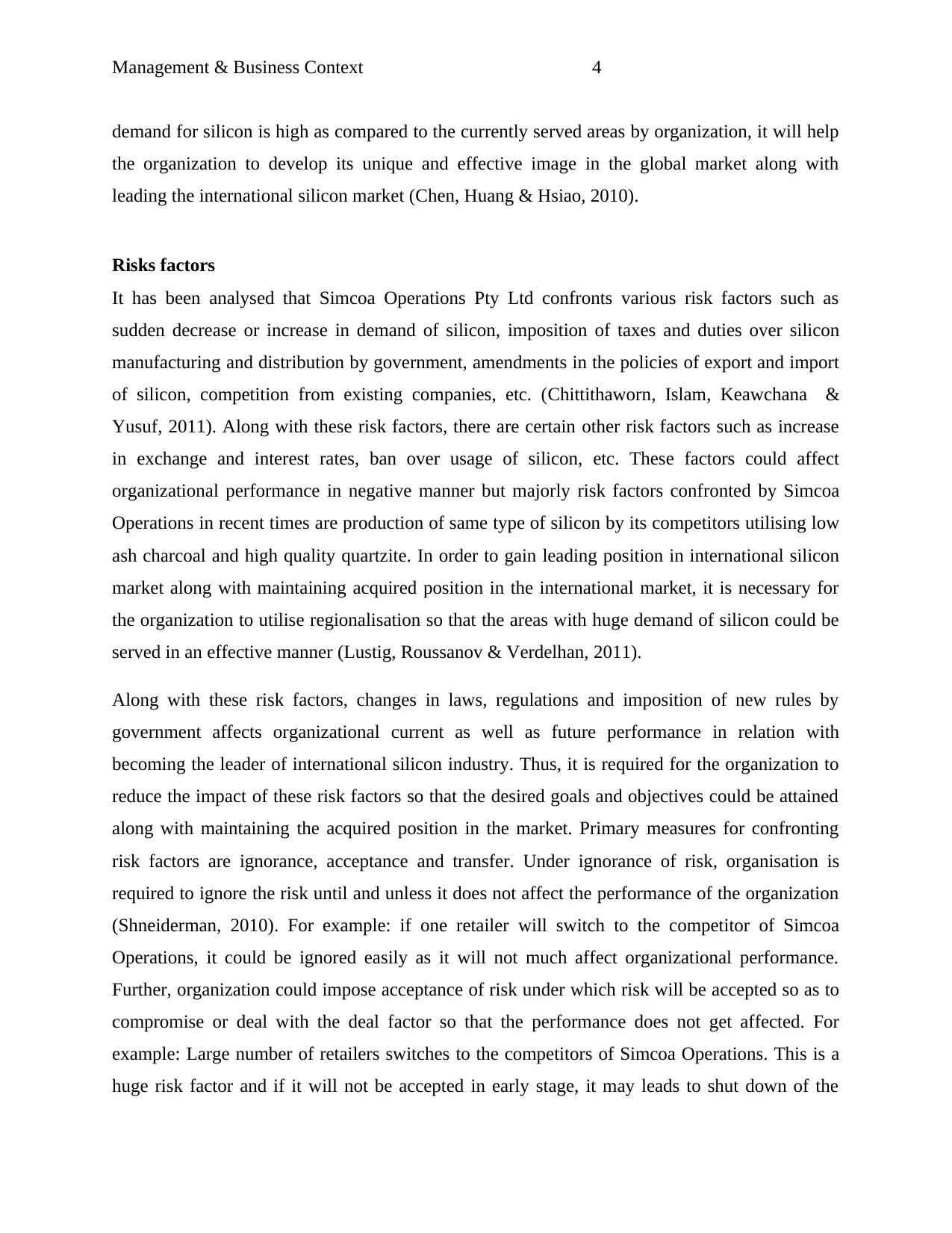
Management & Business Context 4
demand for silicon is high as compared to the currently served areas by organization, it will help
the organization to develop its unique and effective image in the global market along with
leading the international silicon market (Chen, Huang & Hsiao, 2010).
Risks factors
It has been analysed that Simcoa Operations Pty Ltd confronts various risk factors such as
sudden decrease or increase in demand of silicon, imposition of taxes and duties over silicon
manufacturing and distribution by government, amendments in the policies of export and import
of silicon, competition from existing companies, etc. (Chittithaworn, Islam, Keawchana &
Yusuf, 2011). Along with these risk factors, there are certain other risk factors such as increase
in exchange and interest rates, ban over usage of silicon, etc. These factors could affect
organizational performance in negative manner but majorly risk factors confronted by Simcoa
Operations in recent times are production of same type of silicon by its competitors utilising low
ash charcoal and high quality quartzite. In order to gain leading position in international silicon
market along with maintaining acquired position in the international market, it is necessary for
the organization to utilise regionalisation so that the areas with huge demand of silicon could be
served in an effective manner (Lustig, Roussanov & Verdelhan, 2011).
Along with these risk factors, changes in laws, regulations and imposition of new rules by
government affects organizational current as well as future performance in relation with
becoming the leader of international silicon industry. Thus, it is required for the organization to
reduce the impact of these risk factors so that the desired goals and objectives could be attained
along with maintaining the acquired position in the market. Primary measures for confronting
risk factors are ignorance, acceptance and transfer. Under ignorance of risk, organisation is
required to ignore the risk until and unless it does not affect the performance of the organization
(Shneiderman, 2010). For example: if one retailer will switch to the competitor of Simcoa
Operations, it could be ignored easily as it will not much affect organizational performance.
Further, organization could impose acceptance of risk under which risk will be accepted so as to
compromise or deal with the deal factor so that the performance does not get affected. For
example: Large number of retailers switches to the competitors of Simcoa Operations. This is a
huge risk factor and if it will not be accepted in early stage, it may leads to shut down of the
demand for silicon is high as compared to the currently served areas by organization, it will help
the organization to develop its unique and effective image in the global market along with
leading the international silicon market (Chen, Huang & Hsiao, 2010).
Risks factors
It has been analysed that Simcoa Operations Pty Ltd confronts various risk factors such as
sudden decrease or increase in demand of silicon, imposition of taxes and duties over silicon
manufacturing and distribution by government, amendments in the policies of export and import
of silicon, competition from existing companies, etc. (Chittithaworn, Islam, Keawchana &
Yusuf, 2011). Along with these risk factors, there are certain other risk factors such as increase
in exchange and interest rates, ban over usage of silicon, etc. These factors could affect
organizational performance in negative manner but majorly risk factors confronted by Simcoa
Operations in recent times are production of same type of silicon by its competitors utilising low
ash charcoal and high quality quartzite. In order to gain leading position in international silicon
market along with maintaining acquired position in the international market, it is necessary for
the organization to utilise regionalisation so that the areas with huge demand of silicon could be
served in an effective manner (Lustig, Roussanov & Verdelhan, 2011).
Along with these risk factors, changes in laws, regulations and imposition of new rules by
government affects organizational current as well as future performance in relation with
becoming the leader of international silicon industry. Thus, it is required for the organization to
reduce the impact of these risk factors so that the desired goals and objectives could be attained
along with maintaining the acquired position in the market. Primary measures for confronting
risk factors are ignorance, acceptance and transfer. Under ignorance of risk, organisation is
required to ignore the risk until and unless it does not affect the performance of the organization
(Shneiderman, 2010). For example: if one retailer will switch to the competitor of Simcoa
Operations, it could be ignored easily as it will not much affect organizational performance.
Further, organization could impose acceptance of risk under which risk will be accepted so as to
compromise or deal with the deal factor so that the performance does not get affected. For
example: Large number of retailers switches to the competitors of Simcoa Operations. This is a
huge risk factor and if it will not be accepted in early stage, it may leads to shut down of the
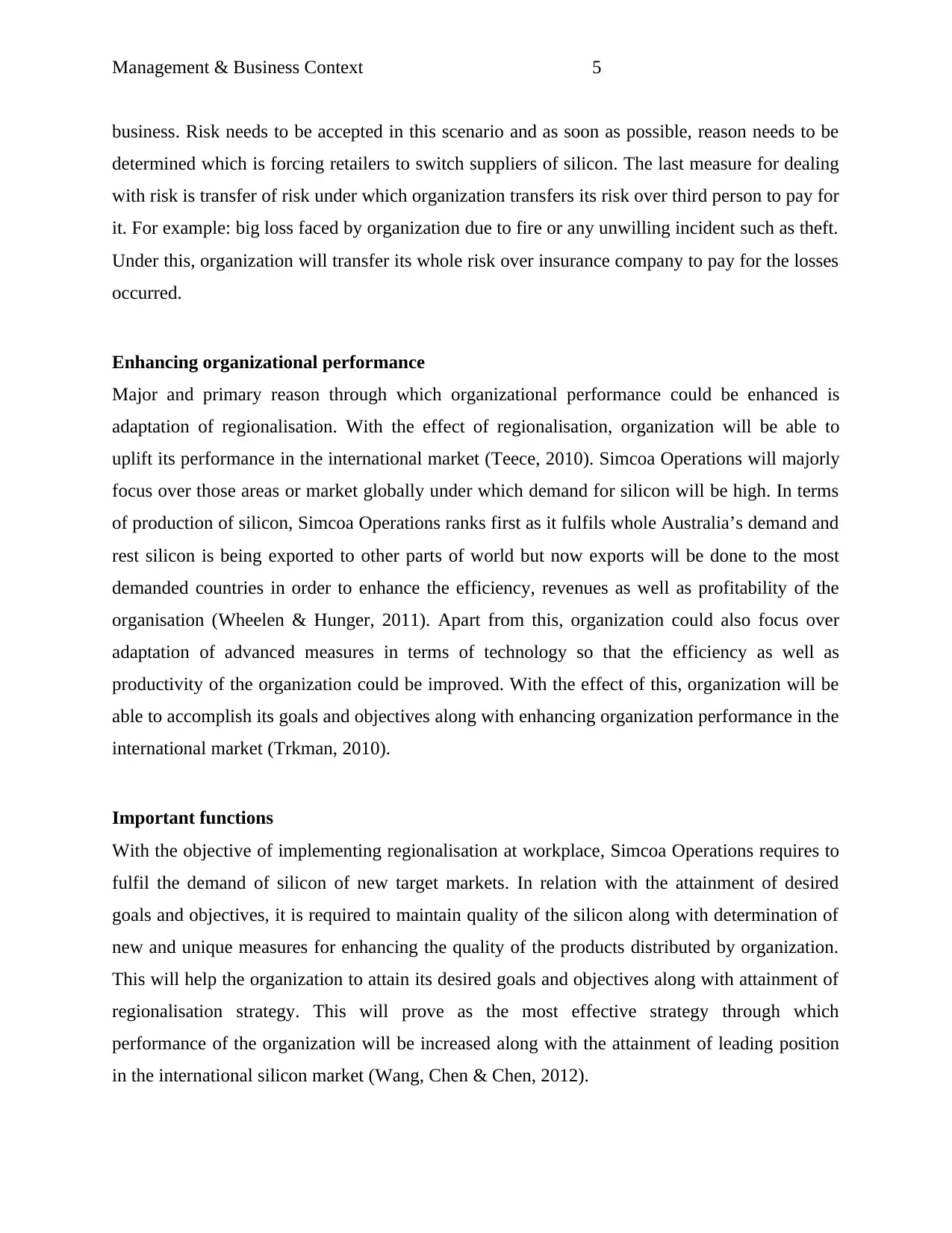
Management & Business Context 5
business. Risk needs to be accepted in this scenario and as soon as possible, reason needs to be
determined which is forcing retailers to switch suppliers of silicon. The last measure for dealing
with risk is transfer of risk under which organization transfers its risk over third person to pay for
it. For example: big loss faced by organization due to fire or any unwilling incident such as theft.
Under this, organization will transfer its whole risk over insurance company to pay for the losses
occurred.
Enhancing organizational performance
Major and primary reason through which organizational performance could be enhanced is
adaptation of regionalisation. With the effect of regionalisation, organization will be able to
uplift its performance in the international market (Teece, 2010). Simcoa Operations will majorly
focus over those areas or market globally under which demand for silicon will be high. In terms
of production of silicon, Simcoa Operations ranks first as it fulfils whole Australia’s demand and
rest silicon is being exported to other parts of world but now exports will be done to the most
demanded countries in order to enhance the efficiency, revenues as well as profitability of the
organisation (Wheelen & Hunger, 2011). Apart from this, organization could also focus over
adaptation of advanced measures in terms of technology so that the efficiency as well as
productivity of the organization could be improved. With the effect of this, organization will be
able to accomplish its goals and objectives along with enhancing organization performance in the
international market (Trkman, 2010).
Important functions
With the objective of implementing regionalisation at workplace, Simcoa Operations requires to
fulfil the demand of silicon of new target markets. In relation with the attainment of desired
goals and objectives, it is required to maintain quality of the silicon along with determination of
new and unique measures for enhancing the quality of the products distributed by organization.
This will help the organization to attain its desired goals and objectives along with attainment of
regionalisation strategy. This will prove as the most effective strategy through which
performance of the organization will be increased along with the attainment of leading position
in the international silicon market (Wang, Chen & Chen, 2012).
business. Risk needs to be accepted in this scenario and as soon as possible, reason needs to be
determined which is forcing retailers to switch suppliers of silicon. The last measure for dealing
with risk is transfer of risk under which organization transfers its risk over third person to pay for
it. For example: big loss faced by organization due to fire or any unwilling incident such as theft.
Under this, organization will transfer its whole risk over insurance company to pay for the losses
occurred.
Enhancing organizational performance
Major and primary reason through which organizational performance could be enhanced is
adaptation of regionalisation. With the effect of regionalisation, organization will be able to
uplift its performance in the international market (Teece, 2010). Simcoa Operations will majorly
focus over those areas or market globally under which demand for silicon will be high. In terms
of production of silicon, Simcoa Operations ranks first as it fulfils whole Australia’s demand and
rest silicon is being exported to other parts of world but now exports will be done to the most
demanded countries in order to enhance the efficiency, revenues as well as profitability of the
organisation (Wheelen & Hunger, 2011). Apart from this, organization could also focus over
adaptation of advanced measures in terms of technology so that the efficiency as well as
productivity of the organization could be improved. With the effect of this, organization will be
able to accomplish its goals and objectives along with enhancing organization performance in the
international market (Trkman, 2010).
Important functions
With the objective of implementing regionalisation at workplace, Simcoa Operations requires to
fulfil the demand of silicon of new target markets. In relation with the attainment of desired
goals and objectives, it is required to maintain quality of the silicon along with determination of
new and unique measures for enhancing the quality of the products distributed by organization.
This will help the organization to attain its desired goals and objectives along with attainment of
regionalisation strategy. This will prove as the most effective strategy through which
performance of the organization will be increased along with the attainment of leading position
in the international silicon market (Wang, Chen & Chen, 2012).
⊘ This is a preview!⊘
Do you want full access?
Subscribe today to unlock all pages.

Trusted by 1+ million students worldwide
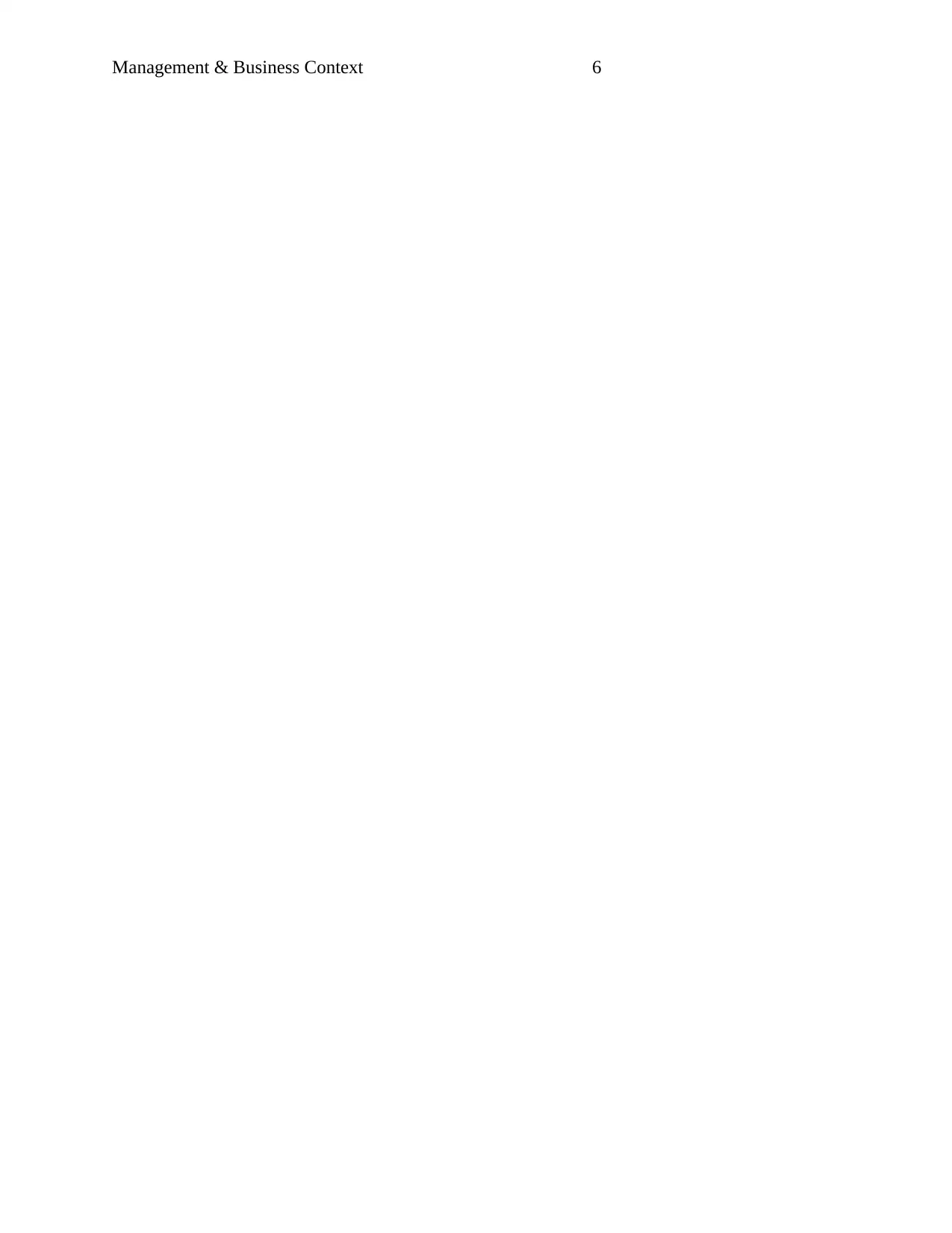
Management & Business Context 6
Paraphrase This Document
Need a fresh take? Get an instant paraphrase of this document with our AI Paraphraser
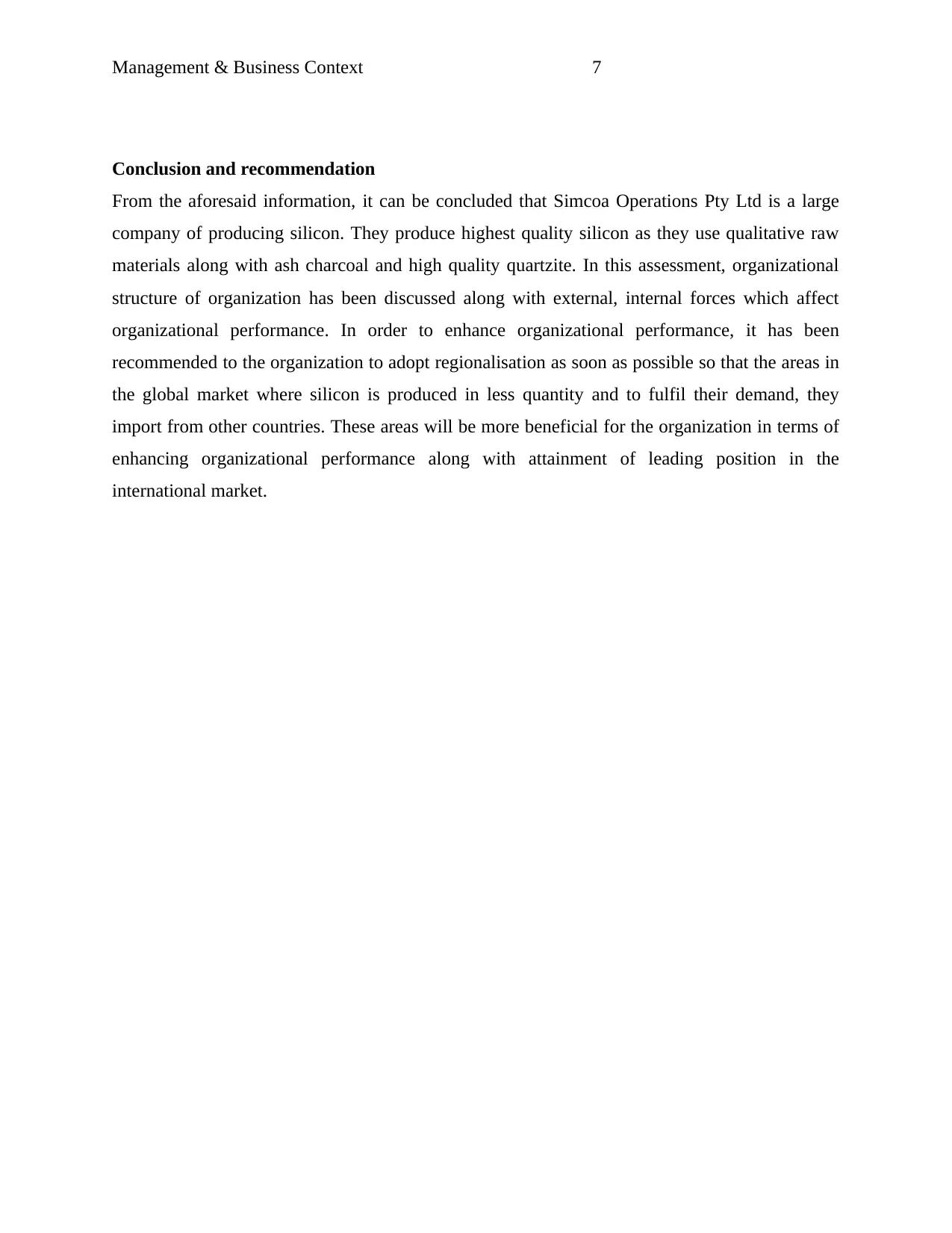
Management & Business Context 7
Conclusion and recommendation
From the aforesaid information, it can be concluded that Simcoa Operations Pty Ltd is a large
company of producing silicon. They produce highest quality silicon as they use qualitative raw
materials along with ash charcoal and high quality quartzite. In this assessment, organizational
structure of organization has been discussed along with external, internal forces which affect
organizational performance. In order to enhance organizational performance, it has been
recommended to the organization to adopt regionalisation as soon as possible so that the areas in
the global market where silicon is produced in less quantity and to fulfil their demand, they
import from other countries. These areas will be more beneficial for the organization in terms of
enhancing organizational performance along with attainment of leading position in the
international market.
Conclusion and recommendation
From the aforesaid information, it can be concluded that Simcoa Operations Pty Ltd is a large
company of producing silicon. They produce highest quality silicon as they use qualitative raw
materials along with ash charcoal and high quality quartzite. In this assessment, organizational
structure of organization has been discussed along with external, internal forces which affect
organizational performance. In order to enhance organizational performance, it has been
recommended to the organization to adopt regionalisation as soon as possible so that the areas in
the global market where silicon is produced in less quantity and to fulfil their demand, they
import from other countries. These areas will be more beneficial for the organization in terms of
enhancing organizational performance along with attainment of leading position in the
international market.
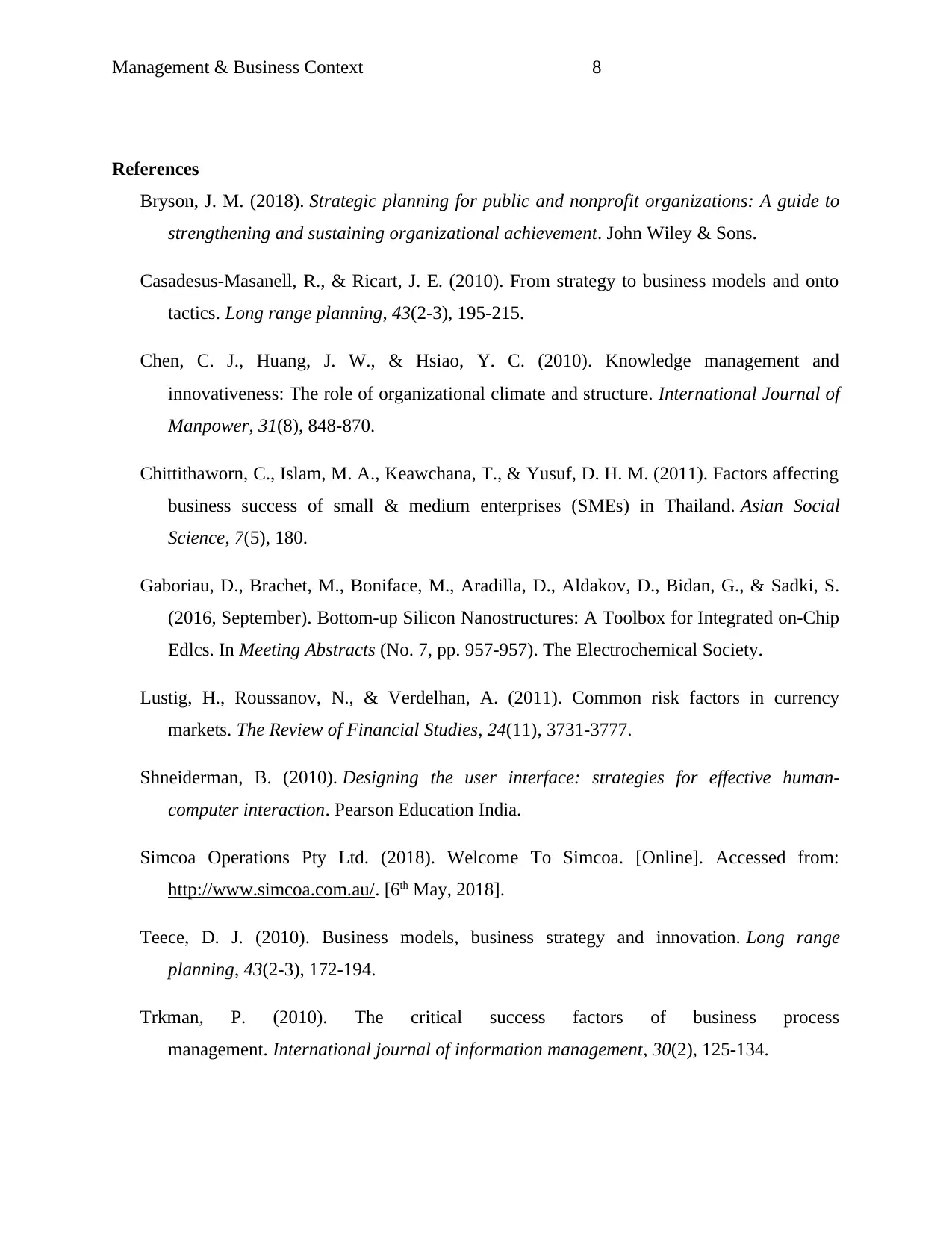
Management & Business Context 8
References
Bryson, J. M. (2018). Strategic planning for public and nonprofit organizations: A guide to
strengthening and sustaining organizational achievement. John Wiley & Sons.
Casadesus-Masanell, R., & Ricart, J. E. (2010). From strategy to business models and onto
tactics. Long range planning, 43(2-3), 195-215.
Chen, C. J., Huang, J. W., & Hsiao, Y. C. (2010). Knowledge management and
innovativeness: The role of organizational climate and structure. International Journal of
Manpower, 31(8), 848-870.
Chittithaworn, C., Islam, M. A., Keawchana, T., & Yusuf, D. H. M. (2011). Factors affecting
business success of small & medium enterprises (SMEs) in Thailand. Asian Social
Science, 7(5), 180.
Gaboriau, D., Brachet, M., Boniface, M., Aradilla, D., Aldakov, D., Bidan, G., & Sadki, S.
(2016, September). Bottom-up Silicon Nanostructures: A Toolbox for Integrated on-Chip
Edlcs. In Meeting Abstracts (No. 7, pp. 957-957). The Electrochemical Society.
Lustig, H., Roussanov, N., & Verdelhan, A. (2011). Common risk factors in currency
markets. The Review of Financial Studies, 24(11), 3731-3777.
Shneiderman, B. (2010). Designing the user interface: strategies for effective human-
computer interaction. Pearson Education India.
Simcoa Operations Pty Ltd. (2018). Welcome To Simcoa. [Online]. Accessed from:
http://www.simcoa.com.au/. [6th May, 2018].
Teece, D. J. (2010). Business models, business strategy and innovation. Long range
planning, 43(2-3), 172-194.
Trkman, P. (2010). The critical success factors of business process
management. International journal of information management, 30(2), 125-134.
References
Bryson, J. M. (2018). Strategic planning for public and nonprofit organizations: A guide to
strengthening and sustaining organizational achievement. John Wiley & Sons.
Casadesus-Masanell, R., & Ricart, J. E. (2010). From strategy to business models and onto
tactics. Long range planning, 43(2-3), 195-215.
Chen, C. J., Huang, J. W., & Hsiao, Y. C. (2010). Knowledge management and
innovativeness: The role of organizational climate and structure. International Journal of
Manpower, 31(8), 848-870.
Chittithaworn, C., Islam, M. A., Keawchana, T., & Yusuf, D. H. M. (2011). Factors affecting
business success of small & medium enterprises (SMEs) in Thailand. Asian Social
Science, 7(5), 180.
Gaboriau, D., Brachet, M., Boniface, M., Aradilla, D., Aldakov, D., Bidan, G., & Sadki, S.
(2016, September). Bottom-up Silicon Nanostructures: A Toolbox for Integrated on-Chip
Edlcs. In Meeting Abstracts (No. 7, pp. 957-957). The Electrochemical Society.
Lustig, H., Roussanov, N., & Verdelhan, A. (2011). Common risk factors in currency
markets. The Review of Financial Studies, 24(11), 3731-3777.
Shneiderman, B. (2010). Designing the user interface: strategies for effective human-
computer interaction. Pearson Education India.
Simcoa Operations Pty Ltd. (2018). Welcome To Simcoa. [Online]. Accessed from:
http://www.simcoa.com.au/. [6th May, 2018].
Teece, D. J. (2010). Business models, business strategy and innovation. Long range
planning, 43(2-3), 172-194.
Trkman, P. (2010). The critical success factors of business process
management. International journal of information management, 30(2), 125-134.
⊘ This is a preview!⊘
Do you want full access?
Subscribe today to unlock all pages.

Trusted by 1+ million students worldwide
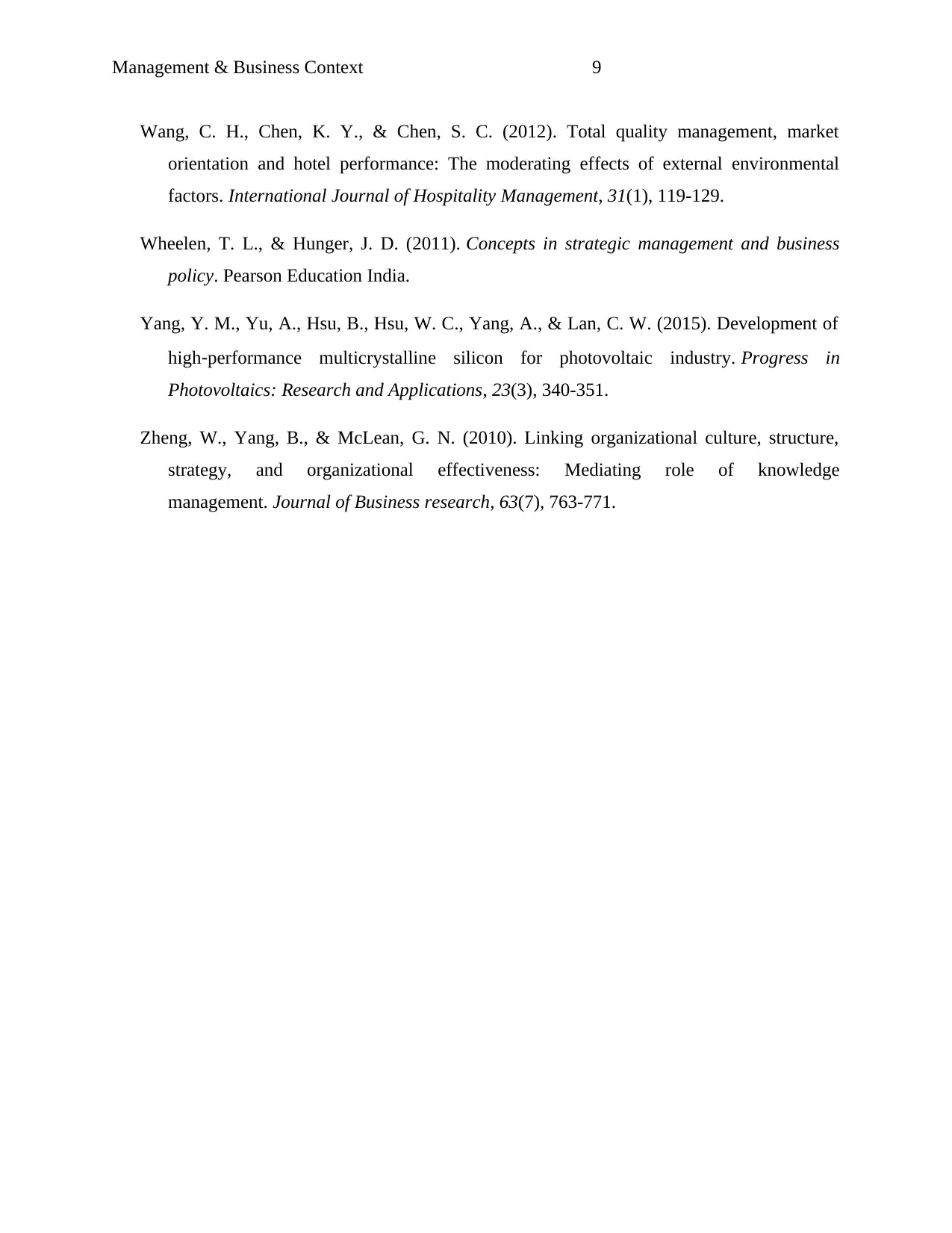
Management & Business Context 9
Wang, C. H., Chen, K. Y., & Chen, S. C. (2012). Total quality management, market
orientation and hotel performance: The moderating effects of external environmental
factors. International Journal of Hospitality Management, 31(1), 119-129.
Wheelen, T. L., & Hunger, J. D. (2011). Concepts in strategic management and business
policy. Pearson Education India.
Yang, Y. M., Yu, A., Hsu, B., Hsu, W. C., Yang, A., & Lan, C. W. (2015). Development of
high‐performance multicrystalline silicon for photovoltaic industry. Progress in
Photovoltaics: Research and Applications, 23(3), 340-351.
Zheng, W., Yang, B., & McLean, G. N. (2010). Linking organizational culture, structure,
strategy, and organizational effectiveness: Mediating role of knowledge
management. Journal of Business research, 63(7), 763-771.
Wang, C. H., Chen, K. Y., & Chen, S. C. (2012). Total quality management, market
orientation and hotel performance: The moderating effects of external environmental
factors. International Journal of Hospitality Management, 31(1), 119-129.
Wheelen, T. L., & Hunger, J. D. (2011). Concepts in strategic management and business
policy. Pearson Education India.
Yang, Y. M., Yu, A., Hsu, B., Hsu, W. C., Yang, A., & Lan, C. W. (2015). Development of
high‐performance multicrystalline silicon for photovoltaic industry. Progress in
Photovoltaics: Research and Applications, 23(3), 340-351.
Zheng, W., Yang, B., & McLean, G. N. (2010). Linking organizational culture, structure,
strategy, and organizational effectiveness: Mediating role of knowledge
management. Journal of Business research, 63(7), 763-771.
1 out of 10
Related Documents
Your All-in-One AI-Powered Toolkit for Academic Success.
+13062052269
info@desklib.com
Available 24*7 on WhatsApp / Email
![[object Object]](/_next/static/media/star-bottom.7253800d.svg)
Unlock your academic potential
Copyright © 2020–2025 A2Z Services. All Rights Reserved. Developed and managed by ZUCOL.





